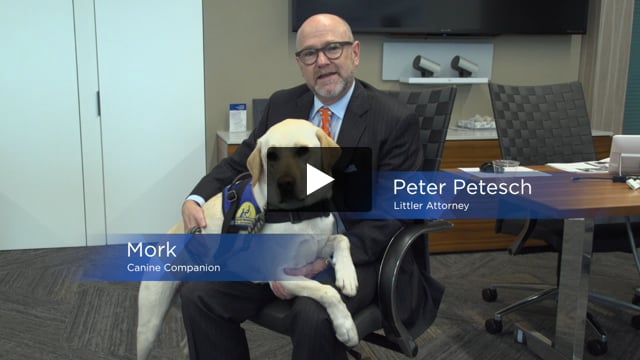Information contained in this publication is intended for informational purposes only and does not constitute legal advice or opinion, nor is it a substitute for the professional judgment of an attorney.
Dear Littler:
I read a New Yorker article about people bringing their dogs everywhere, claiming they were emotional support animals. It mentioned a dog trying to get into Carnegie Hall. But everyone knows there’s only one way to get there: Practice.
Even if Carnegie Hall isn’t your workplace, how do you address employee service animal accommodation requests under the ADA?
- —Hounded with Questions
Dear Hounded,
Well, there are 7 fundamentals at play.
First, note that there are two different sections of the Americans with Disabilities Act, or ADA, that deal with accommodation of service animals. Title I of the ADA addresses workplace accommodations, which is the section you're probably most concerned about. Title III of the ADA governs place of public accommodation, such as a store or doctor's office. The Title III regulations on service animals don’t directly translate to the workplace. The ADA’s Title I employment provisions don’t have the same restricted definitions of a service animal contained in Title III, which limits service animals to dogs and miniature horses. And people don’t have the right to bring pure emotional support dogs to places of public accommodation. Not so under Title I. Title I is . . . fuzzier.
Second, employers can ask more questions about a request for a service animal. Title III limits the questions that can be asked of patrons with service animals in places of public accommodation. But requests for service animals in the workplace should be treated like any other employee request for a reasonable accommodation: you engage with the employee on what the condition is, and what the animal will do to help.
Third, an employer can seek appropriate medical documentation, and of course keep medical information confidential. Bogus requests from people simply wanting to bring their pet to work ruin it for people with legitimate service animal requests. Service animals can help people with conditions varying from vision, hearing and mobility disorders, to less visible disabilities, such as seizure disorders, post-traumatic stress syndrome, and anxiety disorders. Consider seeking certification on the animal’s training and qualifications, but keep in mind that not all legitimate accommodation animals are certified, and it’s easy to get fraudulent certification online for pure pets.
Fourth, set appropriate boundaries and expectations if the employee is ultimately permitted to bring an animal to work. And explore alternatives.
Fifth, don’t jump to the conclusion that the animal won’t work out and will cause a huge disruption. Like with any accommodation, consider giving it a whirl on a trial basis. Then you’ll have a better idea – and better facts.
Sixth, bone up on what you can and can’t say to other employees who ask about the accommodation – because a dog or other animal at work will generate a lot more buzz than someone needing a bigger computer monitor. Under the law, you can’t tell others that the animal is a reasonable accommodation for an employee’s disability. The EEOC says you’re limited to saying: “we’re emphasizing a policy of assisting any employee who encounters difficulties in the workplace.” And that’s it. Don’t get bitten by the ADA’s confidentiality requirements.
Finally, you may have employees concerned about animals in the workplace due to allergies or a fear of animals. Those concerns usually won’t justify simply saying NO to the request for an animal at work.
Employers, do you have a vexing workplace issue? Send your question to DearLittler@littler.com.



